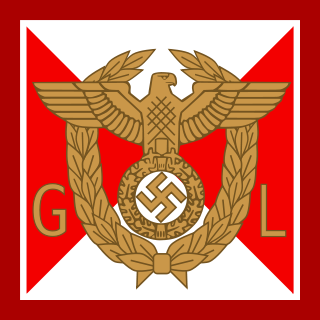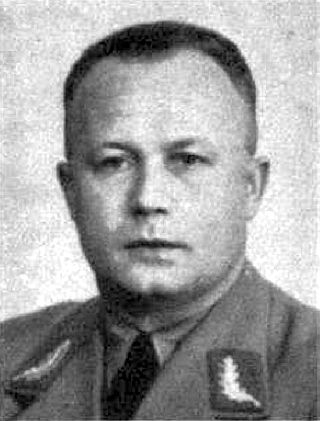
The Nazi Party, officially the National Socialist German Workers' Party, was a far-right political party in Germany active between 1920 and 1945 that created and supported the ideology of Nazism. Its precursor, the German Workers' Party, existed from 1919 to 1920. The Nazi Party emerged from the extremist German nationalist, racist and populist Freikorps paramilitary culture, which fought against communist uprisings in post–World War I Germany. The party was created to draw workers away from communism and into völkisch nationalism. Initially, Nazi political strategy focused on anti–big business, anti-bourgeois, and anti-capitalist rhetoric; it was later downplayed to gain the support of business leaders. By the 1930s, the party's main focus shifted to antisemitic and anti-Marxist themes. The party had little popular support until the Great Depression, when worsening living standards and widespread unemployment drove Germans into political extremism.

The Hitler Youth was the youth organisation of the Nazi Party in Germany. Its origins date back to 1922 and it received the name Hitler-Jugend, Bund deutscher Arbeiterjugend in July 1926. From 1936 until 1945, it was the sole official boys' youth organisation in Germany and it was partially a paramilitary organisation. It was composed of the Hitler Youth proper for male youths aged 14 to 18, and the German Youngsters in the Hitler Youth for younger boys aged 10 to 14.

Der Stahlhelm, Bund der Frontsoldaten, commonly known as Der Stahlhelm, was a German First World War veteran's organisation existing from 1918 to 1935. In the late days of the Weimar Republic, it was closely affiliated to the monarchist German National People's Party (DNVP), placed at party gatherings in the position of armed security guards.

A Gauleiter was a regional leader of the Nazi Party (NSDAP) who served as the head of a Gau or Reichsgau. Gauleiter was the third-highest rank in the Nazi political leadership, subordinate only to Reichsleiter and to the Führer himself. The position was effectively abolished with the fall of the Nazi regime on 8 May 1945.

Fritz Julius Kuhn was a German Nazi activist who served as the elected leader of the German American Bund before World War II. He became a naturalized United States citizen in 1934. Still, his citizenship was canceled in 1943 owing to his status as a foreign agent of Nazi Germany. Kuhn served prison time for larceny and forgery from 1939 to 1943 and, upon release, was immediately interned by the federal government as an enemy agent. He was deported in 1945 and later served further prison time in post-war Germany before dying in 1951.
Heinrich "Heinz" Spanknöbel was a German immigrant to America who formed, and for a short time led, the pro-Nazi Friends of New Germany as its Bundesleiter.

The Nazi Party/Foreign Organization was a branch of the Nazi Party and the 43rd and only non-territorial Gau ("region") of the Party. In German, the organization is referred to as NSDAP/AO, "AO" being the abbreviation of the German compound word Auslands-Organisation. Although Auslands-Organisation would be correctly written as one word, the Nazis chose an obsolete spelling with a hyphen.

Fritz Bracht was the Nazi Gauleiter of Gau Upper Silesia.

Josef Wagner was from 1931 the Nazi Gauleiter of Gau Westphalia-South and, as of December 1934, also of Gau Silesia. In 1941 he was dismissed from his offices, then expelled from the Nazi Party (NSDAP), imprisoned by the Gestapo, and likely executed around the time of end of the war in Europe.

The Gaue were the main administrative divisions of Nazi Germany from 1934 to 1945.
The Free Society of Teutonia was one of the earliest Nazi organizations in the United States. It was officially a German American organization, but also publicly expressed a strong support for Nazi Germany and Nazism in general.
Friends of New Germany, sometimes called Friends of the New Germany, was an organization founded in the United States by German immigrants to support Nazism and the Third Reich.

Gau Swabia, formed on 1 October 1928, was an administrative division of Nazi Germany in Swabia, Bavaria, from 1933 to 1945. From 1928 to 1933, it was the regional subdivision of the Nazi Party in that area.

Gau Bayreuth was an administrative division of Nazi Germany formed by the 19 January 1933 merger of Gaue in Lower Bavaria, Upper Palatinate and Upper Franconia, Bavaria. It was in existence from 1933 to 1945.
Fascism has a long history in North America, with the earliest movements appearing shortly after the rise of fascism in Europe. Fascist movements in North America never gained power, unlike their counterparts in Europe.

A Night at the Garden is a 2017 short documentary film about the 1939 Nazi rally that filled Madison Square Garden in New York City. The film was directed by Marshall Curry from footage found by archival producer Rich Remsberg, and was produced by Laura Poitras and Charlotte Cook with Field of Vision. The seven-minute film is composed entirely of archival footage and features a speech from Fritz Julius Kuhn, the leader of the German American Bund, in which anti-Semitic and pro white-Christian sentiments are espoused.

On February 20, 1939, a Nazi rally took place at Madison Square Garden, organized by the German American Bund. More than 20,000 people attended, and Fritz Julius Kuhn was a featured speaker. The Bund billed the event, which took place two days before George Washington's Birthday, as a pro-"Americanism" rally; the stage at the event featured a huge Washington portrait with swastikas on each side.

Oscar Carl Pfaus was a German immigrant who became an American citizen through military service. He had a succession of jobs before becoming involved in pro-Nazi organizations in Chicago in the early 1930s and becoming a full-time Nazi propagandist there. He was also active in New York.

Nazism in the Americas has existed since the 1930s and continues to exist today. The membership of the earliest groups reflected the sympathies of some German-Americans and German Latin-Americans toward Nazi Germany, embracing the spirit of Nazism in Europe and establishing it within the Americas. Throughout the inter-war period and the outbreak of World War II, American Nazi parties engaged in activities such as sporting Nazi propaganda, storming newspapers, spreading Nazi-sympathetic materials, and infiltrating other non-political organizations.

















